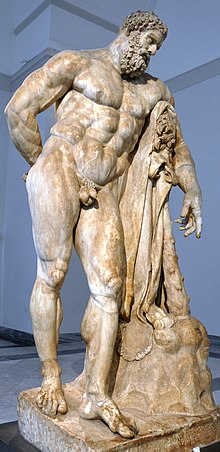
Back Herakles Afrikaans Herakles ALS ሄራክሌስ Amharic هرقل (أسطورة) Arabic Heracles AST Herakl Azerbaijani Геракл Bashkir Herakles BAR Геракл Byelorussian Гэракл BE-X-OLD
The English used in this article or section may not be easy for everybody to understand. (June 2024) |
| Heracles | |
|---|---|
God of strength, heroes, sports, athletes, health, agriculture, fertility, trade, oracles Divine protector of mankind and the patron of the gymnasium | |
 One of the most famous depictions of Heracles, Farnese Hercules, Roman marble statue on the basis of an original by Lysippos, 216 AD. National Archaeological Museum, Naples, Italy | |
| Abode | Mount Olympus |
| Symbol | Club, Nemean lion |
| Personal information | |
| Born | |
| Died | |
| Consort | Hebe and various others |
| Children | Alexiares and Anicetus, Telephus, Hyllus, Tlepolemus |
| Parents | Zeus and Alcmene |
| Siblings | Aeacus, Angelos, Aphrodite, Apollo, Ares, Artemis, Athena, Eileithyia, Enyo, Eris, Ersa, Hebe, Helen of Troy, Hephaestus, Hermes, Minos, Pandia, Persephone, Perseus, Rhadamanthus, the Graces, the Horae, the Litae, the Muses, the Moirai |
| Roman equivalent | Hercules |
| Etruscan equivalent | Hercle |
Heracles (Ancient Greek: Ἡρακλῆς, Hēraklēs - “one glorified of Hera”) is a character in Greek mythology. The greatest of the Greek heroes, Herakles was a demigod, son of Zeus and the mortal Alkmene as well as the twin brother of Iphicles.
Herakles was a patron of heroic endeavor. In Ancient Rome and the modern West, he is known as Hercules. The later Roman emperors, in particular Commodus and Maximian, often identified themselves with him. The figure is best known for his famous Twelve Labors, a series of seemingly impossible tasks he was made to complete in order to atone for the crime of murdering his family. He was said to have started the Ancient Olympic Games and marked out the length of the Olympic stadium. He was the subject of much ancient and modern art, and remains a popular figure in modern times, being the subject of various films and television series, such as Walt Disney's Hercules.